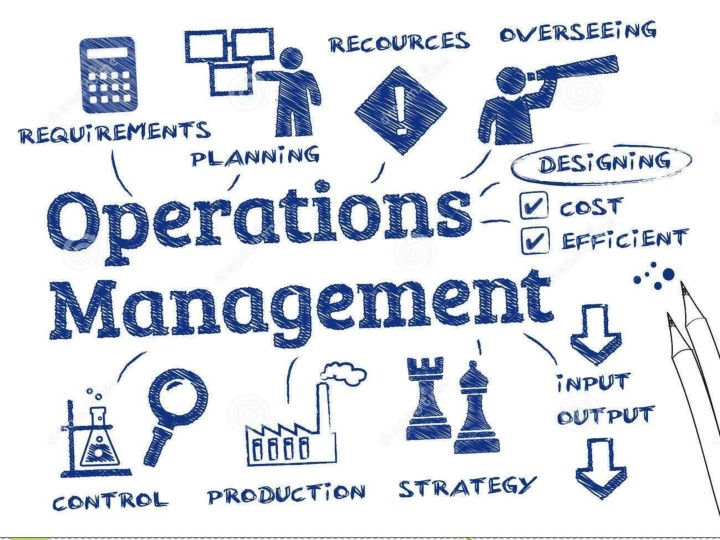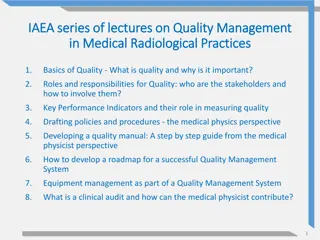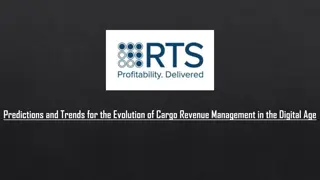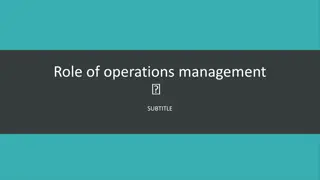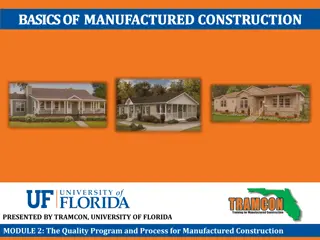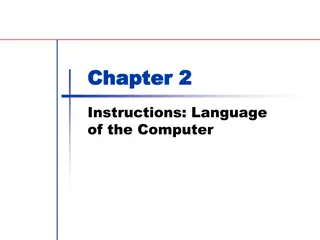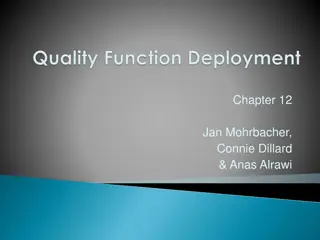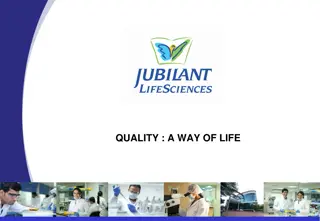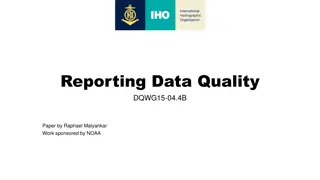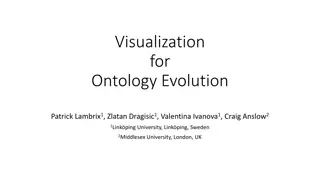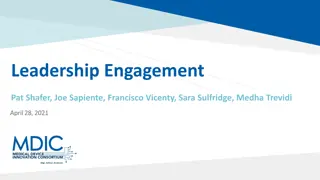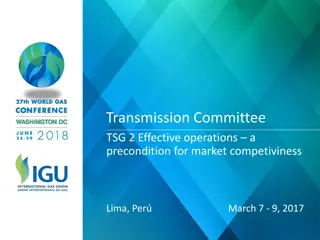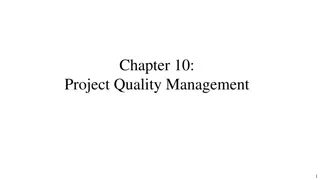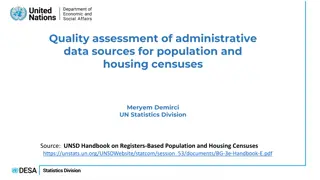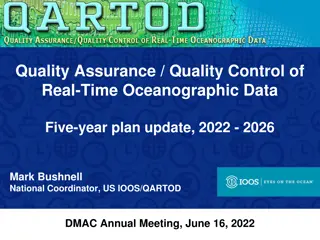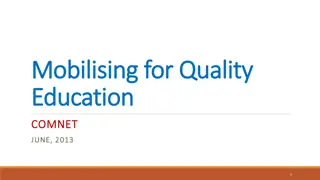Evolution of Operations Management and Quality in Global Environment
Operations management involves efficiently converting materials and labor into goods and services to maximize profits. Explore the evolution of operations management from historical structures to modern practices while focusing on quality and competitiveness in a global context. Understand the significance of planning, strategy, supply chain management, and more in enhancing organizational performance.
Download Presentation

Please find below an Image/Link to download the presentation.
The content on the website is provided AS IS for your information and personal use only. It may not be sold, licensed, or shared on other websites without obtaining consent from the author.If you encounter any issues during the download, it is possible that the publisher has removed the file from their server.
You are allowed to download the files provided on this website for personal or commercial use, subject to the condition that they are used lawfully. All files are the property of their respective owners.
The content on the website is provided AS IS for your information and personal use only. It may not be sold, licensed, or shared on other websites without obtaining consent from the author.
E N D
Presentation Transcript
Quality and Competitiveness in a Global Environment
Defining OperationsManagement The management of systems or processes that create goods and/or provide services Operations management converting materials and labour into goods and services as efficiently as possible to maximize the profit of an organization. is concerned with
The Evolution of Operations Management One of the oldest management technique The Pyramids of Egypt The Great Wall of China The Roads and the Aqueducts of Rome Operations Management begin with Industrial Revolution in the 1700s, when Craft Production is converted into factory When a series of industrial inventions and mechanically powered machines have taken place
OM ROADMAP Product & Services Quality Management Global Operations Processes, Capacity & Technology Project Managemen t Quality Statistical Process Control Facilities Human Resources Supply Chain Management
LearningIncludes Introduction Planning Strategy Supply Chain management JIT Quality Project Management PERT Diagram & GANTTChart Services
Operations as a Transformation Process Transformation Process Product Design Process Planning Production Control Maintenance Input Man Material Machine Money Information Output Product Services Feedback Continues Inventory Quantity Cost
DefiningPlanning The process of thinking and organizing the required activities to achieve a desired goal Plan=Internal Plan is concrete Defining A S p t lr a a nt o e fag cy t i o n designed to achieve a long- term or overall aim. Strategy=External Strategy is abstract
BASIS FOR COMPARISON PLANNING STRATEGY Meaning Planning is thinking in advance, for the actions which are going to take place in the future. Best plan opted for achieving thedesired outcome. What is it? Planning is a road map for accomplishing any task. Strategy is the path chosen for achievingthe objectives. Relatedto Thinking Action Basis Assumptions Practical considerations Term Long Term Depending uponthe circumstances. Nature Preventive Competitive Part of Management Functions Sub-part of Decision Making Yes Sequence Second First
Types of Planning Aggregate Planning DRP Distribution planning requirements (DRP) It is an operational activity is a that does plan process, in advance of 6 to 18 months, to give an idea to management as to what quantity of materials and other resources are to be procured and when, so that the total cost of operations of the organization is kept to the minimum over that period. an aggregate the production systematic process to make the delivery of goods more efficient which goods, quantities, and location are meet anticipated The goal shortages costs of transporting, goods. for by determining in at required demand. to minimize what what to is and reduce the ordering, and holding
Types of Strategy Level Strategy the company continuously produces goods equal to the average demand for the goods Chase Strategy Chase strategy, or Demand Matching Strategy, produce only enough goods to meet or exactly match the demand for goods Hybrid Strategy Hybrid strategies as strategies which enable to associate low cost production and differentiation
Supply Chain Management It is the collaborative effort of multiple channel members to design, implement and manage seamless value added process to meet the real need of end customer Supply Chain Structure Responsivenes s Efficiency Transportatio n Inventory Facilities Information Consolidation Dedicated Proximity/Flexi bility Efficiency Responsivenes s Best Suited for each Objective Cost of Holding Availability Consolidation Speed
Dealer/Supplier Order placed to EDI Value chain of Amazon or any E- tailer Factory Customer Delivery Distribution Warehouse
Just In Time (JIT) Eliminating waste JIT is an inventory strategy companies employ to increase efficiency and decrease waste by receiving goods only as they are needed in the production process, there by reducing inventory cost This method requires that producers are able to accurately forecast the demand JIT concept goes hand in hand with concept such as Kanban, continuous improvement and (TQM) Technology plays an important role in JIT, an information system such as ERP is required to implement JIT in any organization.
Just In Time (JIT) Disadvantage s Little room for mistakes Production is relied on suppliers Advantages of JIT Lower on stock holding Lesser working capital Avoids buildup of unsold finished products Lesser time on quality inspection
JIT can Achieve Reducing cost Improving Quality Improving Performance Improving Delivery Adding Flexibility Increasing Innovation
Quality Quality is assurance which satisfies the customer s expectation QC Quality Control QA QualityAssuranc e Six Sigma Lean Thinking Theory of Constraint Constraint drive waste Identify constraint Exploit Constraint Sub-ordinate Cons Elevate Cons Repeat Cycle Views of waste Variation is waste Non-value adding in market Identify value Define value stream Determine the flow Define Pull Improve Process Visualize Process Flow Application Define Measure Analyze Improve Control Tools Focus Math, Stats Problem System thinking Constraint
ProjectManagement It is temporary endeavor with a defined beginning & end undertaken to meet your need, goals, and objectives, typically to bring about beneficial change or add value Planning & Design Monitorin g Initiation Execution Closure BAU (Business As Usual) Initiation Planning & Design Monitoring & Controlling Execution Closure
ProjectTriangle Quality Time
WBS (Work Breakdown Structure)
PERTChart A PERT chart is a project management tool used to schedule, organize, and coordinate tasks within a project. PERT stands for Program Evaluation Review Technique, a methodology developed by the U.S. Navy in the 1950s to manage the Polaris submarine missile program.
GANTTChart A Gantt chart is a horizontal bar chart developed as a production control tool in 1917 by Henry L. Gantt, an American engineer and social scientist. Frequently used in project management, a Gantt chart provides a graphical illustration of a schedule that helps to plan, coordinate, and track specific tasks in a project.
Services Any activity or benefit that one party can offer to another that is essentially intangible and does not result the ownership of anything. It is production may or may not be tied up to a physical products Types of services Pure Service Product Linked Service Product Based Service
SERVICES Intangible Heterogeneous Cannot be stored Production, Distribution, and Consumption takes place simultaneously GOODS Tangible Homogenous Produced in a factory Transfer of ownership
Production The action of making or manufacturing from raw materials, or the process of being so manufactured TYPES of Production systems T-Type Y-Type Reverse Y-Type I-Type
